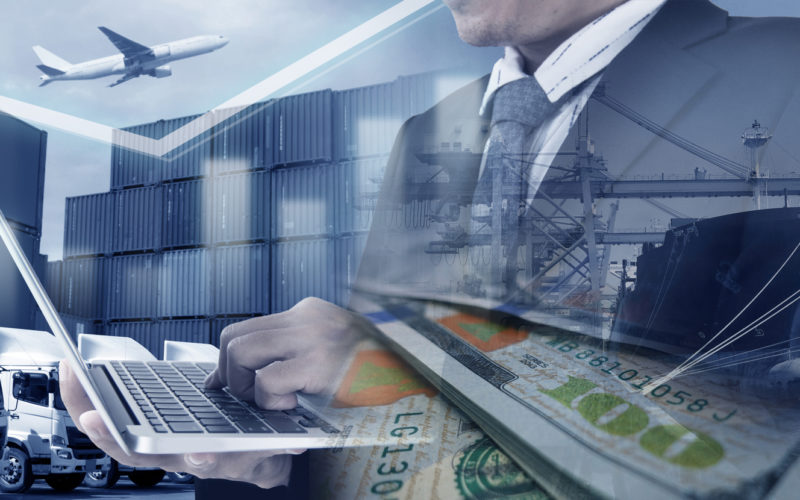If you’ve traveled on an interstate highway lately and have had the experience of being boxed in by semi-trailers and blinded by the spray these big rigs produce, you can probably relate to the common feeling that there are far too many of these trucks on the roads and that there must be a better way for companies to transport goods. However, as inconvenient as it is to share the roads with these massive vehicles, they play a vital role in modern commerce, transporting everything from gasoline to avocados from producers to distributors to end users.
Unfortunately, the trucks sharing the road with you are usually under capacity and often empty. But this doesn’t have to be the case. There is a huge potential to leverage technology to optimize transport and logistics, reduce the number of trucks on the roads, lower costs, and improve environmental outcomes. This article explores one framework (the “physical Internet”) that aims to improve the efficiency of the global supply chain.
Our thoughts here are based on a white paper by USPS and an article from the Fraser Institute, a Canadian think tank.
What is the physical internet?
Companies have started to digitally transform their supply chains. They do this by deploying solutions that enable them to analyze their businesses based on the exact physical constraints of their supply chains and the true economic fundamentals of the markets they serve. We explain this process as digitizing the supply chain because it involves the creation of a digital twin of the supply chain. Once this has been achieved, users can run scenarios to optimize their business decisions and maximize profit margins.
The physical Internet is the same concept, but it goes one step further by sharing assets across all shippers and carrier companies to maximize transport and logistics efficiency in the global supply chain. So far, the theory has only been applied to consumer goods, packages, and mail. However, it is applicable to physical commodities such as oil, gas, and natural gas liquids (NGLs).
Imagine autonomous trucks packed optimally to carry the perfect number of boxes, and traveling to and from hubs rather than distant distribution centers. Those hubs are stocked with exactly the right amount of product from e-commerce businesses across the globe. Trips are shorter. Trucks are packed and routed based on maximum efficiency. Communication between businesses, fulfillment hubs, trucks, and customers are seamless.
The concept of the physical Internet has been around since 2006. It’s originator, Benoit Montreuil, saw an opportunity to move boxes and parcels around physical supply chains in the same way that bytes move through the digital Internet. We are a long way from achieving the physical Internet. However, making it a reality by 2050 is a goal of the Alliance for Logistics Innovation.
What’s wrong with the current approach?
The current approach to logistics is wasteful, inefficient, and costly. Goods move from production facilities to company-specific distribution centers, where inventory is wasted and assets are underused. Trucks and ships travel to the delivery locations under capacity and make return trips empty. For example:
- 45% of cargo ships travel empty (dry bulk and container ships).
- 60% of trucks on the roads are below full capacity.
- 50% of many commodity hauls (crude trucks, frac sand, and water trucks) are empty due to one-way trade routes.
This results in transport and logistics costs being much more expensive than necessary—hitting consumer budgets and causing unnecessary negative environmental and social externalities.
Why would we want to copy the digital Internet for physical logistics?
The Internet we use every day for searching, networking, emailing, and more is a collaborative, cooperative space. It isn’t governed by any one website or corporation controlling how information is delivered and received. Instead, different companies and people share information across a network of different data paths. For example, if you and a friend use different email providers, you can still send emails to one another quickly and efficiently. As such, the digital Internet exhibits the characteristics of an efficient supply chain.
According to the Internet Society, “the Internet’s unprecedented success continues to thrive because the Internet model is open, transparent, and collaborative. The model relies on processes and products that are local, bottom-up, and accessible to users around the world.” Internet users and operators follow standards that are unilaterally adopted. Data is shared between users. The Internet reduces search costs for consumers, which allows users to optimize decisions in a short amount of time. In short, the Internet is badass!
So how do we make logistics more like the Internet?
The physical Internet relies on a few driving forces to take the current logistics system into the new era:
- Standardization. Dlivery mechanisms, packages, and parcels need to be commoditized to enable uniform processes to be adopted.
- Democratization. Data from all shippers and carriers is shared to optimize which carriers move whose goods. Distribution centers should function more like cloud storage, which doesn’t discriminate about who stores data in them. Sharing assets drives down costs and increases efficiency.
- Smart Transport. Autonomous vehicles that are loaded with the most efficient group of goods are dynamically routed to minimize loaded miles. Deadhead miles are minimized through sharing data between all shippers and carriers.
- Communication Platform. A platform that reduces search costs and enables seamless risk-sharing between shippers and carriers—think Uber or the stock exchange—will create a perfectly competitive market.
Assuming that these technologies can be developed and unified adoption of standards can be achieved, the physical Internet will become a reality.
Are these driving forces the same for commodities supply chains?
In a lot of ways, commodities have some advantages over standard freight when it comes to logistics efficiency. By definition, commodities are standardized and meet particular specifications. Hence, they are fungible and can generally be mixed together and traded based on international standards and benchmarks. In terms of smart transport, autonomous trains are already being used by Riot Tinto in Australia’s Pilbara to transport iron ore from mines to ports.
How can companies digitize their supply chains, and how can capSpire help?
The biggest challenges facing commodities-trading organizations is technology adoption and democratization of data. capSpire, a leader in digital transformation, has solutions for both.
capSpire’s supply chain optimization platform brings this technology into organizations. It is an example of a solution that can digitize supply chains and enable analysis of various scenarios, as discussed earlier, and can routinely boost profit margins by 20 to 40%. In an increasingly competitive industry, this equates to significant profit improvements.
The limitation of capSpire’s supply chain optimization platform is that it is centered around an individual organization’s assets—owned or contracted—rather than sharing information and assets between companies.
However, capSpire’s web portal Gravitate is helping companies to better transact and communicate with their customers and suppliers. For instance, 5% of all corn sold in the U.S. happens in Gravitate, where farmers sell corn directly to national distributors using a phone app. capSpire is also launching a trading platform to optimize the use of crude oil assets, which will benefit crude marketers. We’ll discuss this technology development in future blogs.
To start your digital transformation, contact info@capspire.com to arrange a demo of our supply chain optimization platform and Gravitate, or to discuss your unique challenges and how we can help.
About capSpire
capSpire provides the unique combination of industry knowledge and business expertise required to deliver impactful business solutions. Trusted by some of the world’s leading companies, capSpire’s team of industry experts and senior advisors empowers its clients with the business strategies and solutions required to effectively streamline business processes and attain maximum value from their supporting IT infrastructure. For more information, please visit www.capspire.com.










